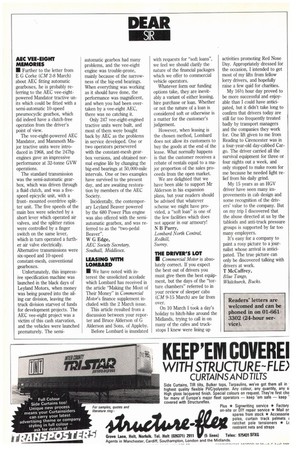AEC VEE-EIGHT MEMORIES • Further to the letter from E
Page 32

If you've noticed an error in this article please click here to report it so we can fix it.
G Corke (CM 2-8 March) about AEC fitting automatic gearboxes, he is probably referring to the AEC vee-eightpowered Mandator tractive units which could be fitted with a semi-automatic 10-speed pneumocyclic gearbox, which did indeed have a clutch-free operation from the driver's point of view.
The vee-eight-powered AEC Mandator, and Mammoth Major tractive units were introduced in 1968, and the 247hp engines gave an impressive performance at 32-tonne GVW operations.
The standard transmission was the semi-automatic gearbox, which was driven through a fluid clutch, and was a fivespeed epicyclic unit, with a frontmounted overdrive split. ter unit. The five speeds of the main box were selected by a short lever which operated air valves, and the splitter ratios were controlled by a finger switch on the same lever, which in turn operated a further air valve electrically. Alternative transmissions were six-speed and 10-speed constant-mesh, conventional gearboxes.
Unfortunately, this impressive specification machine was launched in the black days of Leyland Motors, when money was being poured into the ailing car division, leaving the truck division starved of funds for development projects. The AEC vee-eight project was a victim of this cash starvation, and the vehicles were launched prematurely. The semi automatic gearbox had many problems, and the vee-eight engine was trouble-prone, mainly because of the narrowness of the big-end bearings. When everything was working as it should have done, the performance was magnificent, and when you had been overtaken by a vee-eight AEC, there was no catching it.
Only 247 vee-eight-engined tractive units were built, and most of them were bought back by AEC as the problems in service developed. One or two operators persevered with the constant-mesh gearbox versions, and obtained normal engine life by changing the big-end bearings at 50,000-mile intervals. One or two examples have survived to the present day, and are awaiting restoration by members of the AEC Society.
Incidentally, the contemporary Leyland Beaver powered by the 680 Power Plus engine was also offered with the semiautomatic gearbox, and was referred to as the "two-pedal Beaver".
W G Edge,
AEC Society Secretary, Southall, Middlesex.








































































































































